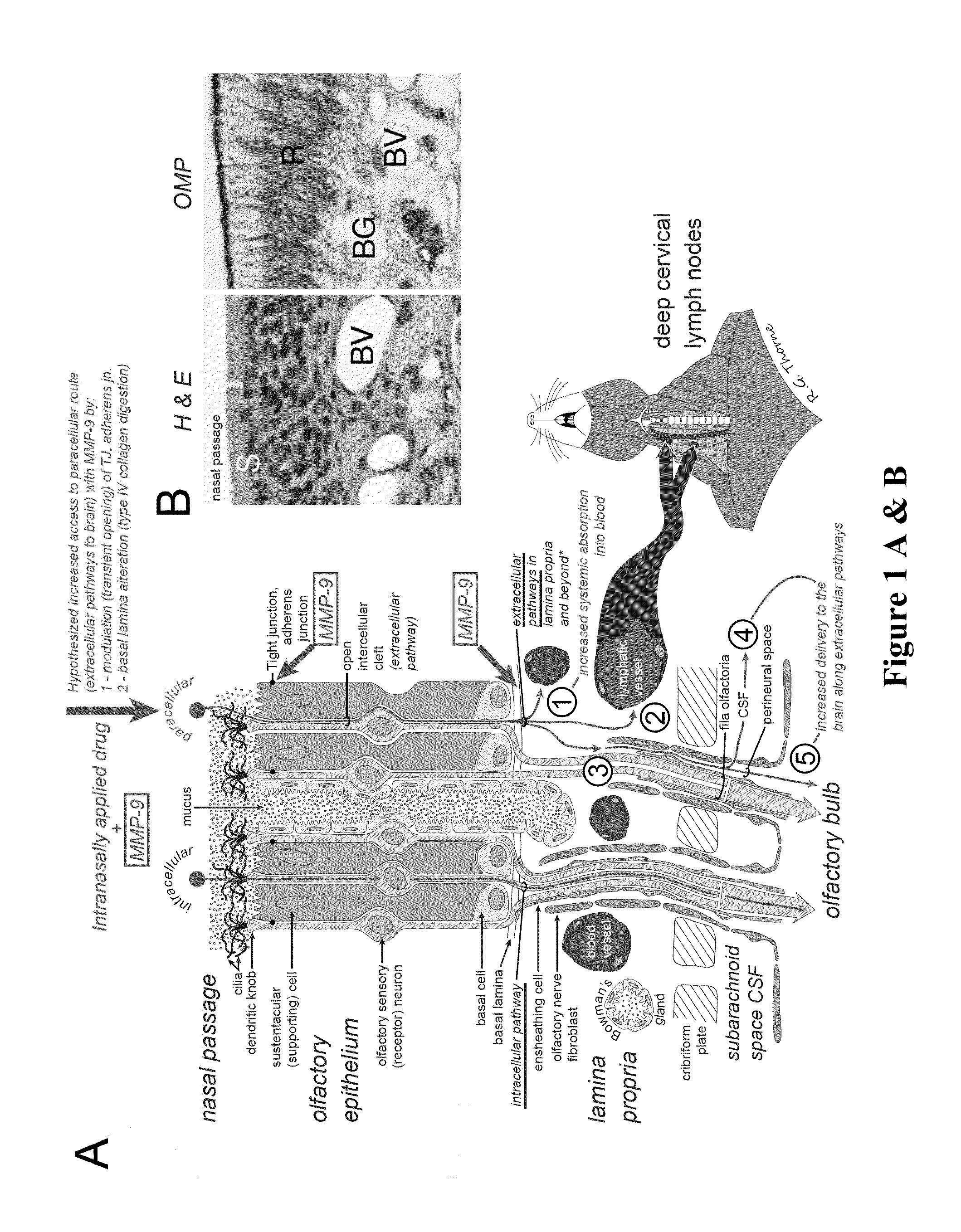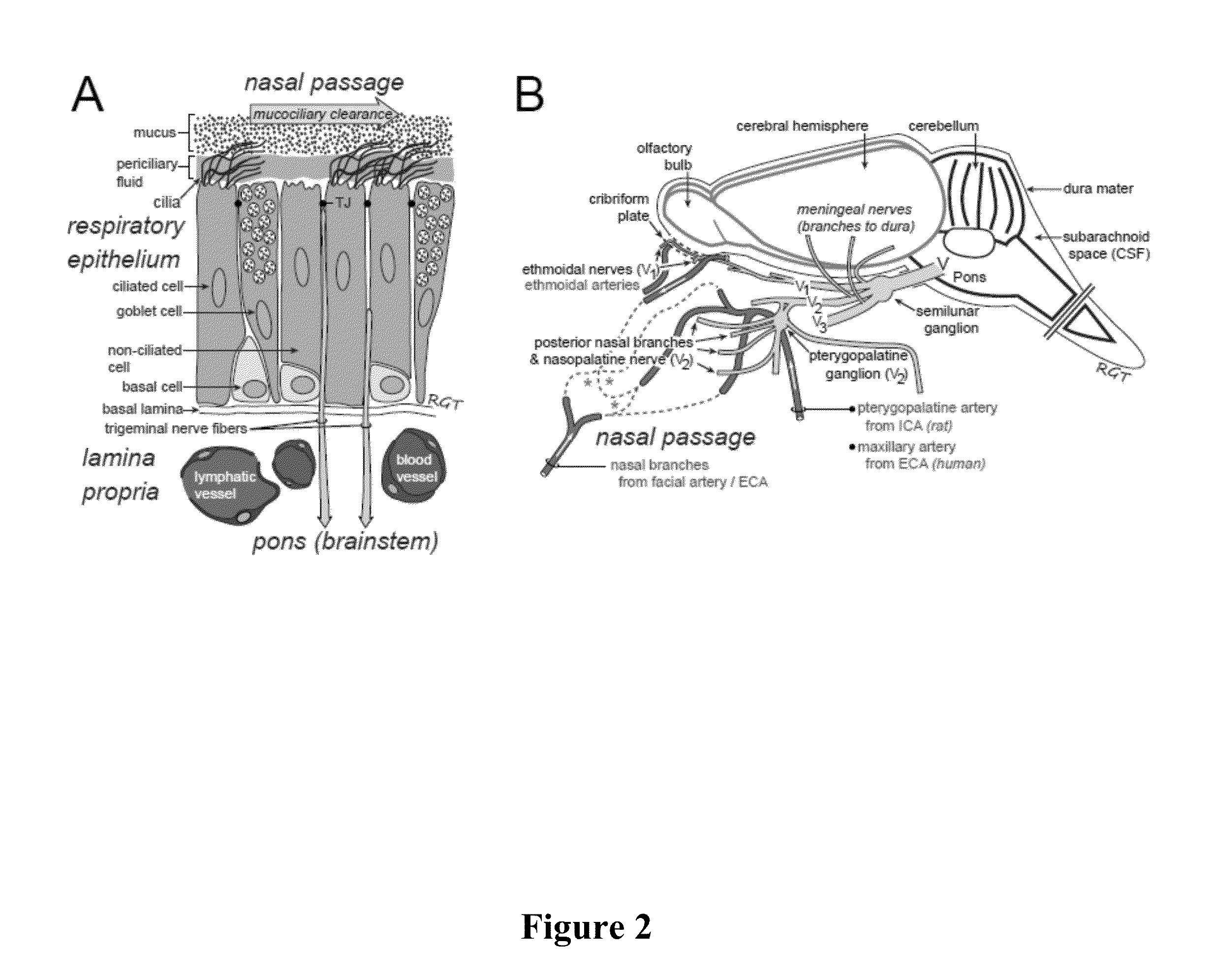Methods and Compositions for Enhancing Intranasal Delivery of Therapeutic Agents
a technology of intranasal delivery and composition, which is applied in the direction of drug compositions, antibody medical ingredients, peptide/protein ingredients, etc., can solve the problems of poor dissolution of the intranasal permeability, and the inability to fully absorb the intranasal permeability
- Summary
- Abstract
- Description
- Claims
- Application Information
AI Technical Summary
Benefits of technology
Problems solved by technology
Method used
Image
Examples
example 1
[0141]Intranasal Administration of MMP-9 or its Functionally Equivalent Fragment and Active Compounds.
[0142]In the present example, MMP-9 or its functionally equivalent fragment and active compounds in their respective effective amount are intranasally applied to the patients such as rats in a subsequent or a simultaneous manner. MMP-9 or its functionally equivalent fragment is initially prepared as an aqueous solution having a concentration of 100 nanomolar (nM). Female Sprague Dawley rats (180-220 g) were anesthetized with urethane (1.5 g / kg i.p.). Either saline or a MMP-9 or its functionally equivalent fragment solution (100 nM) was intranasally (IN) administered to alternating nares in 6 μL drops every 5 minutes (total volume=24 μL). This was followed by intranasal administration of 3 kDa lysine-fixable Texas Red dextran (Dex3, Invitrogen; 50 g / L) or 10 kDa lysine-fixable Texas Red dextran (Dex10, Invitrogen; 50 g / L) to alternating nares in 6 μL drops every 5 minutes (total volu...
example 2
[0151]Intranasal Administration of MMP-2 and Active Compounds.
[0152]As another member of matrix metalloproteinases (MMP) family, matrix metalloproteinase-2 (MMP-2; gelatinase A) shows some similarity in structure to that of MMP-9 or its functionally equivalent fragment. Therefore, the functionalities of MMP-2 with MMP-9 or its functionally equivalent fragment are compared for enhancing intranasal delivery of active compounds. Referring now to FIG. 10, widespread cerebral perivascular fluorescence images are depicted following intranasal (IN) applications (left and center) or intra-arterial (IA) applications (right) of Texas Red-labeled 10 kDa dextran (Dex10) after intranasal (IN) applications of MMP-9 or its functionally equivalent fragment (100 nM; left and right) or matrix metalloproteinase-2 (MMP-2; 300 nM; center). Images observed following intranasal applications of MMP-2 (300 nM) and Dex10 in a subsequent manner (center) fail to detect fluorescence spectra of Dex10, indicating...
example 3
[0153]Intranasal Co-Administration of MMP-9 And Active Compounds.
[0154]Fluorescently labeled 10 kDa dextran (dex10) was used as an example of active compounds. The present invention may be applied to any other suitable active compounds. Intranasal co-administration of MMP-9 and fluorescently labeled 10 kDa dextran (dex10) results in widespread perivascular distribution in the brain. As shown in FIG. 11, rats were initially anesthetized with urethane and administered 12 μl drops of dex10 (25 mg / ml) in alternating nares every 5 minutes (48 μL total) with (A) or without (B) MMP-9 (100 nM). After 30 minutes following the first drop, rats were perfused with phosphate buffered saline followed by 4% paraformaldehyde. The brain was removed and 1 mm thick sections were viewed under an Olympus MVX10 fluorescent macro zoom microscope equipped with a Texas Red filter set. Images from the brainstem were acquired with an Orca-flash 2.8 CMOS camera (Hamamatsu) at the same magnification under the s...
PUM
| Property | Measurement | Unit |
|---|---|---|
| thick | aaaaa | aaaaa |
| time | aaaaa | aaaaa |
| concentrations | aaaaa | aaaaa |
Abstract
Description
Claims
Application Information
 Login to View More
Login to View More - R&D
- Intellectual Property
- Life Sciences
- Materials
- Tech Scout
- Unparalleled Data Quality
- Higher Quality Content
- 60% Fewer Hallucinations
Browse by: Latest US Patents, China's latest patents, Technical Efficacy Thesaurus, Application Domain, Technology Topic, Popular Technical Reports.
© 2025 PatSnap. All rights reserved.Legal|Privacy policy|Modern Slavery Act Transparency Statement|Sitemap|About US| Contact US: help@patsnap.com



